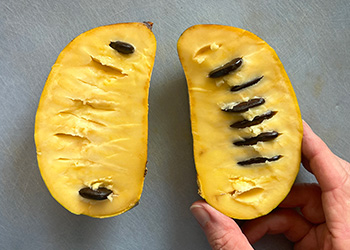Pawpaw
This native tree has a unique place in American history

Troy Evans, Great Smoky Mountains National Park, Bugwood.org.
If you are looking to add some fall color to your landscape or want to diversify your native edibles, then pawpaw is the tree for you. Common pawpaw (Asimina triloba) is deciduous and can provide a showy display of yellow leaves that eventually fall in autumn. Aside from its colorful display, the tree also provides a fruit sweet enough to rival bananas and tempt both people and wildlife.
Characteristics
This native grows best in North Florida and typically matures to a height of 15 or 20 feet. The leaves are dark green and usually 6 to 12 inches long and 3 to 5 inches wide. The tree has a unique drooping appearance, as if the stems can barely support the weight of the leaves.

Photo: Scott Zona, some rights reserved.
Common pawpaw blooms in springtime, producing leathery red, purple or pink-colored flowers that are 2 inches wide. They may be pleasing to the eye, but the blooms are not praised for their fragrance. Neither are the leaves, which when crushed, release an unpleasant smell that serves as a unique identifying trait.
The flowers are followed by an interesting fruit. Roughly 3 to 6 inches long, the fruits start out green and mature into a range of colors from green to yellow to blackish brown. Ripe pawpaws should give when squeezed gently, similar to a ripe peach. The ripened fruits have wrinkled skin and soft, custardy flesh that is dotted with large seeds. These edible fruits are appreciated by wildlife, with raccoons and birds frequently snatching them up. Pawpaw fruits are actually large berries and are also called “custard apples.” The flavor is similar to a banana and the fruit is quite nutritious. They are perfect for desserts, smoothies or straight off the tree.
Historically, Native Americans and early American settlers foraged for pawpaw when crops failed. It even kept members of the Lewis and Clark Expedition fed during their travels and served as food for enslaved people seeking freedom, providing sustenance on their dangerous journeys. These unique trees are rooted in folklore, even inspiring a song, “Way down yonder in the pawpaw patch.”
Today, pawpaw is cultivated with several varieties. ‘Mango’ is known for its vigorous growth and mango-banana flavor. ‘Overleese’ produces large fruits with a sweeter taste, and ‘Collin’s’ is a particularly good choice for the South. Others include the ‘Southern Seedling’ and ‘Sweet Potato’ pawpaw trees.
There are about 11 native pawpaw species, including the netted pawpaw (Asimina reticulata), which is found widely throughout peninsular Florida. Smallflower pawpaw (Asimina parviflora) is found from central Florida north to the panhandle. Manasota pawpaw (Asimina manasota) is only found in Manatee and Sarasota counties.
Caution: Be aware that certain parts of the plant can be mildly toxic to humans — eating the fruit skin or seeds can cause intestinal or stomach pain. You can also experience skin irritation from handling the fruit. Do not consume the leaves or stems.
Planting and Care

This tree is incredibly easy to please since it grows in all light conditions, is moderately drought tolerant, and can survive flooding. However, you should plant common pawpaw in full sun if you desire the lushest canopy. It is more suitable for North Florida, hardy in zones 5A through 8B. The ideal soil is rich, moist and slightly acidic. Common pawpaw can be easily propagated by seeds, layering or root cuttings. Pruning should be minimal, except for maintaining the shape or for removing dead, diseased or crossing branches.
While pawpaw does experience pests like the pawpaw peduncle borer (Talponia plummeriana), it attracts beneficial insects as well. You may spot zebra swallowtail (Protographium marcellus) caterpillars feeding on the foliage. This butterfly is the only kite swallowtail native to the US, and Asimina species, including pawpaw, are its host plants. Throughout most of its range, common pawpaw is its main host, but in Florida and other southern states, a variety of pawpaw species are used. Keep an eye out for these showy, striped butterflies once they are fully grown!
This native tree would make a perfect addition to any fruit grove or yard, with tasty fruits and attractive blossoms sure to provide enjoyment to any gardener. Check out your local plant nursery for pawpaw varieties to add to your landscape.
Also on Gardening Solutions
More from UF/IFAS
- Pawpaw: A Fruit with an Identity Crisis–Gardening in the Panhandle
- Zebra Swallowtail, Protographium marcellus–Ask IFAS
KSU Pawpaw Program
Kentucky State University has the only full-time pawpaw research program in the world as part of the KSU Land Grant Program.
